In a world brimming with diversity, where each corner carries its own unique blend of traditions and customs, navigating through unfamiliar cultures can be both exhilarating and daunting. As wanderlust fills our hearts and our passports crave new stamps, it becomes imperative to embrace the art of cultural etiquette – the delicate dance of respectful behavior when traveling abroad. While knowing the basics of “please” and “thank you” may seem like a good starting point, delving deeper into the nuances of different societies is where true harmony lies. So, whether you’re journeying to the bustling streets of Tokyo or the vibrant markets of Marrakech, join us as we unravel the enchanting tapestry of cultural etiquette, ensuring respectful interactions that transcend language barriers and leave lasting impressions of unity and respect.
Understanding Cultural Differences in Greetings
When it comes to greetings, different cultures have their own unique customs and traditions. These customs go beyond a simple “hello” and offer a glimpse into the values and social norms of a particular society. Exploring these cultural differences in greetings not only helps us connect with people from other backgrounds, but also fosters mutual understanding and respect. Let’s dive into some fascinating examples of cultural greetings from around the world.
1. Bowing in Japan: In Japan, bowing is an integral part of their greeting etiquette. The depth of the bow indicates the level of respect being shown. A casual acquaintance may receive a slight nod, while deep bows are reserved for formal occasions or when greeting elders. This custom highlights the importance of humility and hierarchy in Japanese society.
2. Handshakes and kisses: While handshakes are a common greeting in many Western cultures, the number of kisses on the cheek can vary in other parts of the world. For example, in France, it is customary to exchange kisses on both cheeks, while in some Latin American countries, a single kiss is the norm. Understanding these variations can prevent misunderstandings and awkward situations when greeting people from different cultures.
3. “Namaste” in India: In India, the traditional greeting is “Namaste,” a gesture of respect and gratitude. It involves folding the hands together and slightly bowing the head. The word “Namaste” loosely translates to “I bow to the divine within you.” This greeting emphasizes the spiritual connections between individuals and serves as a reminder of the importance of acknowledging the inner light in every person.
By recognizing and respecting cultural differences in greetings, we can break down barriers and build bridges between different communities. These cultural nuances offer us the opportunity to learn and appreciate the rich diversity of our world. So, next time you encounter a different greeting, remember to embrace it with an open mind and a smile!

Navigating Table Manners and Dining Etiquette Abroad
When it comes to exploring different cultures, understanding table manners and dining etiquette is essential. Every country has its own unique customs and traditions surrounding food, and being aware of these can help you navigate social situations with ease while avoiding any unintentional faux pas. Here are some tips and insights to help you maintain a respectful and enjoyable dining experience while abroad:
1. Respect Local Customs:
One of the most important aspects of dining etiquette abroad is respecting the customs of the country you’re visiting. Take the time to research and familiarize yourself with their traditions. For example, while slurping your soup may be impolite in some cultures, it is actually a sign of appreciation in others, such as in Japan. Being aware of and respecting these differences will not only help you fit in but also show your host that you are appreciative and open to their culture.
2. Observe and Learn:
Observing those around you can be a great way to pick up on local dining etiquette. Pay attention to how people use their cutlery, how they hold their utensils, and even how they sit at the table. Some cultures may have specific rules on which hand to use for eating, or certain gestures to avoid. Once you have a good idea of the local customs, try to mimic what others are doing. This way, you’ll not only blend in but also show respect and appreciation for the local traditions.
3. Take Your Time:
Dining abroad is often seen as a social experience, and it is generally expected to take a leisurely approach to your meal. Embrace the slower pace and take your time enjoying the food and the company around you. Rushing through a meal can be seen as rude or disrespectful in many cultures. So, sit back, relax, and savor each bite. Additionally, don’t forget to engage in polite conversation with your fellow diners; it’s considered a way to build rapport and strengthen relationships.

Respecting Personal Space and Gestures in Foreign Cultures
Understanding Boundaries and Mannerisms Abroad
When venturing into foreign lands, it is important to recognize that personal space and gestures can vary significantly from one culture to another. Respecting these norms not only demonstrates cultural sensitivity but also helps foster positive interactions with locals. So, before embarking on your next adventure, take a moment to delve into the fascinating world of personal boundaries across diverse cultures.
1. Embrace the Art of Personal Space
We all cherish our personal space, but its boundaries can differ greatly depending on where you are in the world. Remember these important variations:
- North America and Europe: These regions tend to uphold the concept of individual space, so maintain a comfortable distance when engaging in conversation.
- Latin America and the Middle East: In these cultures, people are generally more accustomed to closer proximity. Don’t be surprised if conversations feel more intimate and friendly.
- Asia and Africa: Here, personal boundaries encompass a wider spectrum. Some countries may have preferences for more personal space, while others may consider closer interactions as signs of trust and respect.
2. Decode Nonverbal Cues
Gestures are a form of nonverbal communication that can either bring people closer or create unintentional misunderstandings. Pay attention to the following nonverbal cues:
- Eye Contact: While direct eye contact is seen as a sign of respect in many Western cultures, it can be interpreted as confrontational or disrespectful in certain Asian countries. Be attentive to the local conventions.
- Hand Gestures: Hand signals can hold various meanings across cultures. For example, the “thumbs up” gesture may convey positivity in the West, but in parts of the Middle East, it can be considered offensive. Familiarize yourself with common gestures and their cultural connotations.
- Body Language: Postures and physical contact can also differ by region. For instance, hugging or touching strangers may be common in some Latin American cultures, while it may be less prevalent in East Asian contexts.
3. Adapt and Learn
While it is impossible to master every cultural nuance, displaying a willingness to adapt and learn can go a long way. Remember these essential tips:
- Observe Locals: Observe the behavior of locals and follow their lead in terms of personal space and gestures.
- Ask Questions: When in doubt, politely ask for guidance or clarification from someone familiar with the local customs. Most people are happy to help and appreciate your effort to understand their culture.
- Be Open-Minded: Embrace the differences and accept that what may be considered impolite in your culture could be perfectly acceptable in another.
Remember, respect for personal space and gestures is an invaluable aspect of cross-cultural interactions. By embracing these differences, you can ensure more enjoyable, meaningful, and harmonious experiences during your travels.

Adapting to Dress Codes and Modesty Customs Overseas
When traveling or living overseas, it’s important to respect and adapt to local customs, particularly when it comes to dress codes and modesty. Each country has its own unique set of traditions and expectations, and by being mindful of these cultural norms, we not only show respect for the local customs but also ensure a more comfortable and enjoyable experience for ourselves.
One way to adapt to dress codes and modesty customs overseas is by researching and understanding the local customs before your trip. Learn about traditional clothing, religious practices, and social expectations of the country you plan to visit. This will help you pack appropriate clothing options that align with local standards and avoid any unintentional offenses.
When visiting religious sites or conservative communities, it’s essential to dress modestly. Ensure your shoulders, chest, and knees are covered to show respect and avoid drawing unnecessary attention. Loose-fitting clothes that provide coverage will help you blend in and demonstrate cultural sensitivity. Additionally, it’s useful to carry a scarf or shawl that can be used as a head covering if required.
Remember that adapting to different dress codes doesn’t mean sacrificing your personal style. Embrace the opportunity to explore and purchase traditional clothing items from local markets or shops. Not only will this contribute to your overall travel experience, but it will also show an appreciation for the culture and traditions of the country you’re visiting.

Elevating Communication: Language and Conversation Etiquette in Different Countries
When it comes to effective communication, language and conversation etiquette play a vital role. However, these aspects can vary greatly across different countries, adding an intriguing layer to intercultural interactions. Let’s explore some fascinating examples of how various cultures around the world approach language and conversation.
1. Silence is Golden in Japan: In Japan, silence is highly valued and is often used as a form of communication in itself. Pauses during conversations are considered respectful, allowing speakers to reflect on their thoughts before responding. Interrupting someone while they are talking is seen as impolite. So, it’s essential to be patient and embrace the occasional silence when conversing with Japanese counterparts.
2. Eloquence in France: French culture places a significant emphasis on eloquence and the art of conversation. The French take pride in their language and value the use of refined vocabulary and sophisticated gestures. It’s common for conversations to be lively, filled with expressive hand gestures and elaborate descriptions. Engaging in vibrant discussions with the French is an excellent way to delve into their culture and build rapport.
3. Direct and Indirect Communication in Germany: Germans value directness and honesty in communication. They appreciate straightforward and concise conversations without excessive use of pleasantries. However, it’s essential to avoid interrupting others, as Germans highly respect each person’s turn to speak. Unlike in France, where eloquence reigns, conversations in Germany tend to focus more on efficiency and getting to the point.
Exploring the diverse language and conversation etiquette across different countries allows us to expand our understanding of cultures and promote effective cross-cultural communication. Embracing these variations helps us navigate conversations respectfully and create meaningful connections beyond linguistic barriers.
To Wrap It Up
As we conclude our exploration of cultural etiquette and respectful behavior when traveling abroad, let us embrace the richness and diversity that our world has to offer. In traversing unfamiliar lands and encountering different customs, we have expanded our understanding, fostered meaningful connections, and grown as global citizens.
Remember, dear reader, that cultural etiquette is not merely a set of rules to follow but an endeavor to deepen our appreciation for the human tapestry that surrounds us. It is an invitation to celebrate the myriad of traditions, gestures, and rituals that shape our global community.
We encourage you to approach your future journeys with an open mind and an eagerness to learn. Immerse yourself in the customs and traditions of the places you visit, for in doing so, you will discover the true essence of a destination, unlocking a world of wonders that surpasses guidebook descriptions.
As ambassadors of goodwill, let respect and empathy be our guiding principles in every encounter. Embrace the unfamiliar with curiosity, and extend a hand of genuine friendship to those you meet along the way. By weaving the threads of understanding, we can bridge the gaps between cultures and foster a harmonious global coexistence.
Remember, a smile knows no language barriers, and a gesture of appreciation can transcend words. Embrace local customs, adapting your behavior to reflect the values and beliefs of those you encounter. In doing so, you become not just a traveler passing through but a temporary participant, a beloved visitor welcomed into the heart of a foreign land.
Thus, as we bid farewell, we implore you to embark on your future adventures with grace, humility, and a boundless thirst for knowledge. Embrace the tapestry of cultural diversity that lies beyond your borders, for in doing so, you enrich not only your own life but the collective human experience.
May your travels be filled with unforgettable moments and transformative encounters. With cultural etiquette as our compass, let us become the legacy of unity, understanding, and respect that the world so desperately needs.
Bon voyage, dear reader, and may your journey bring you unparalleled joy, knowledge, and beneath every traveler’s feet, the promise of a shared humanity.




